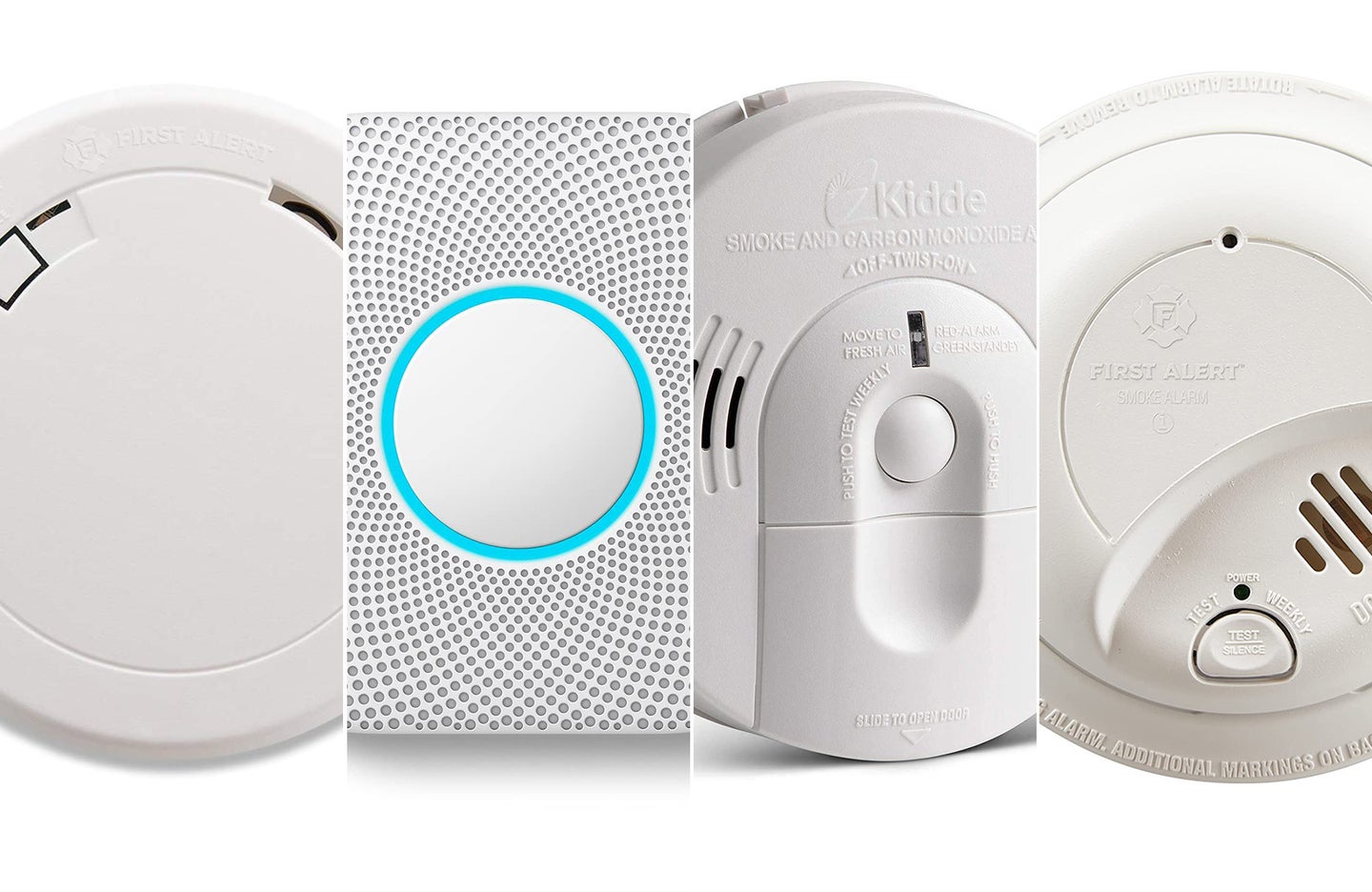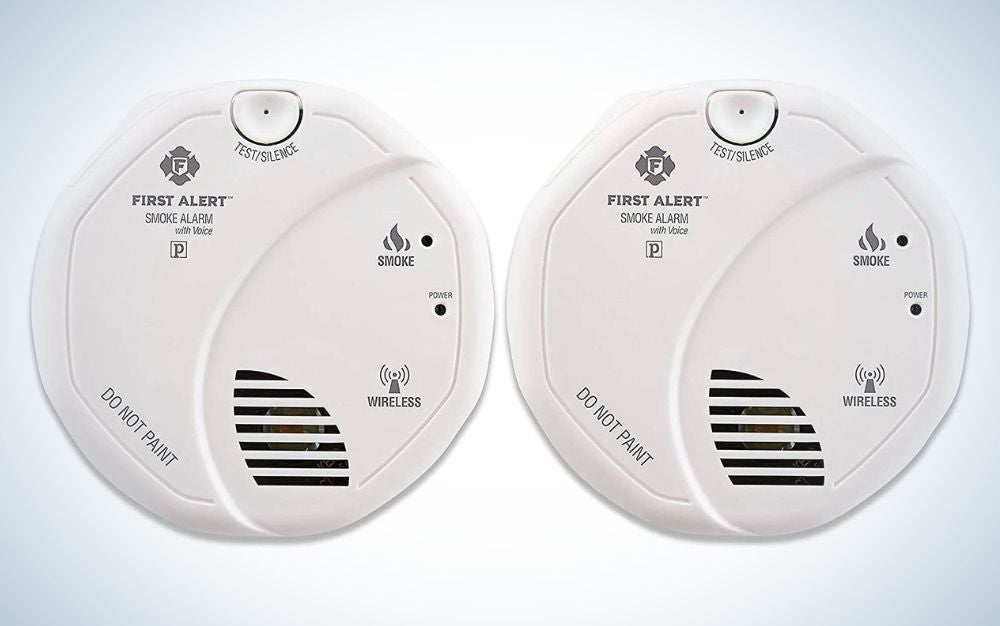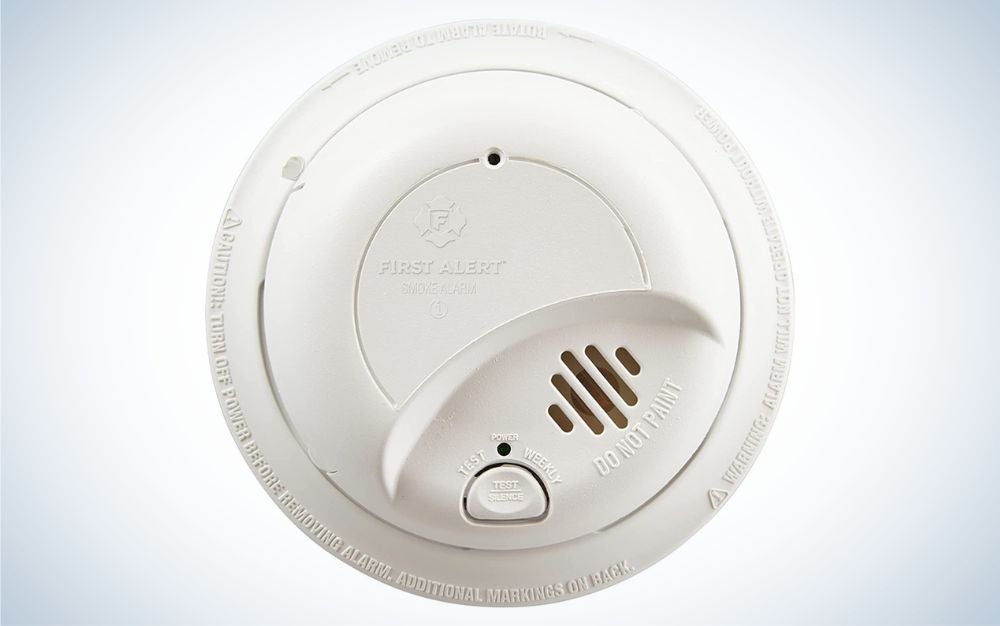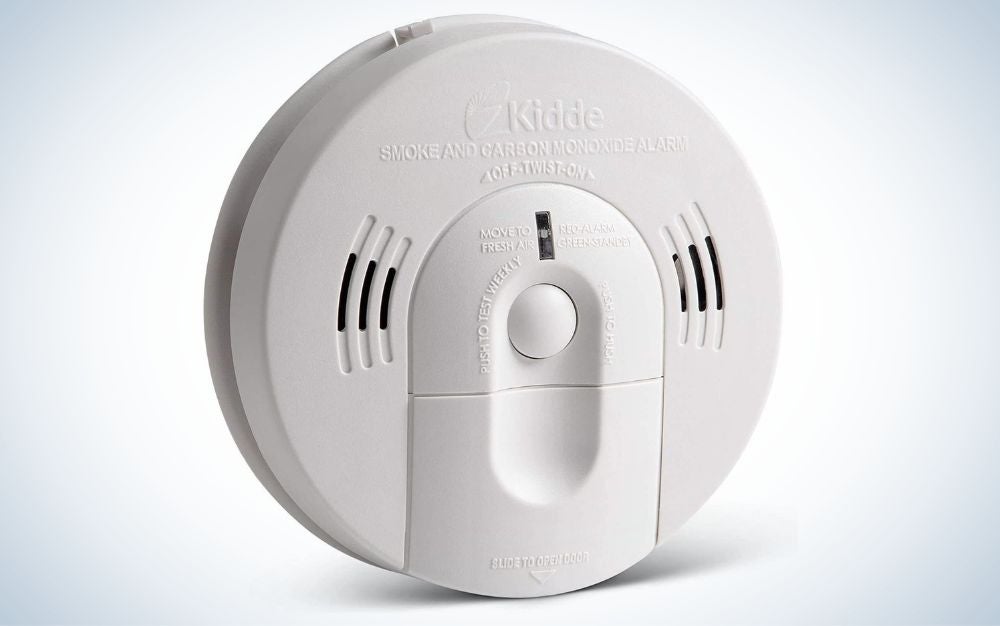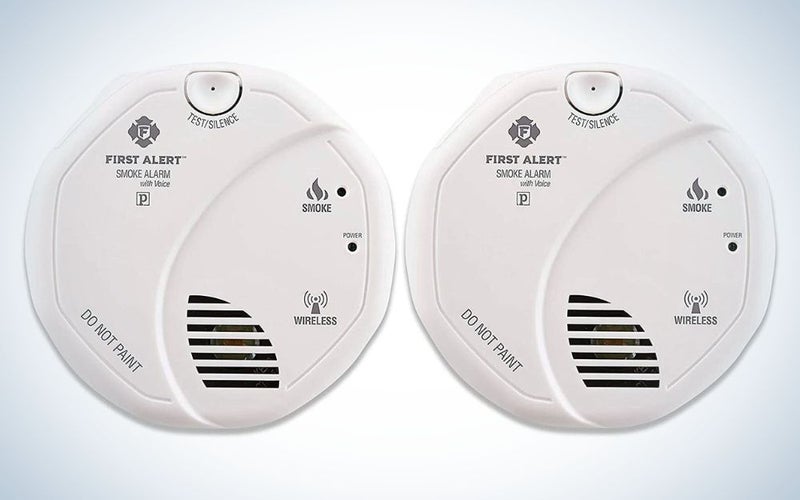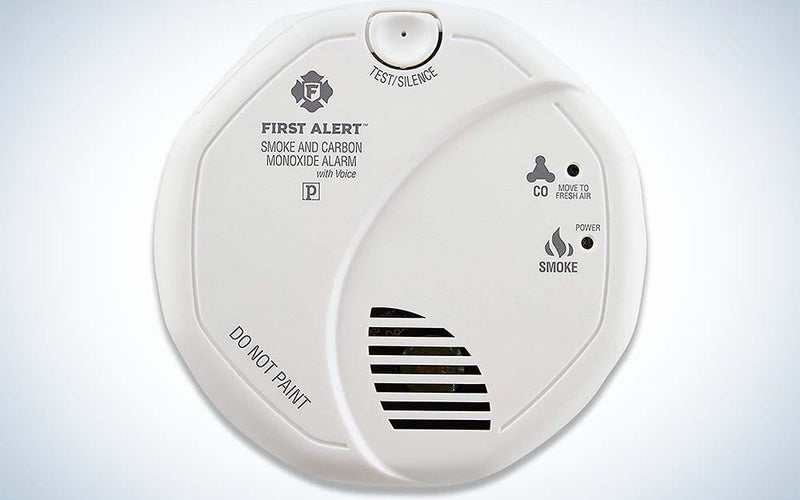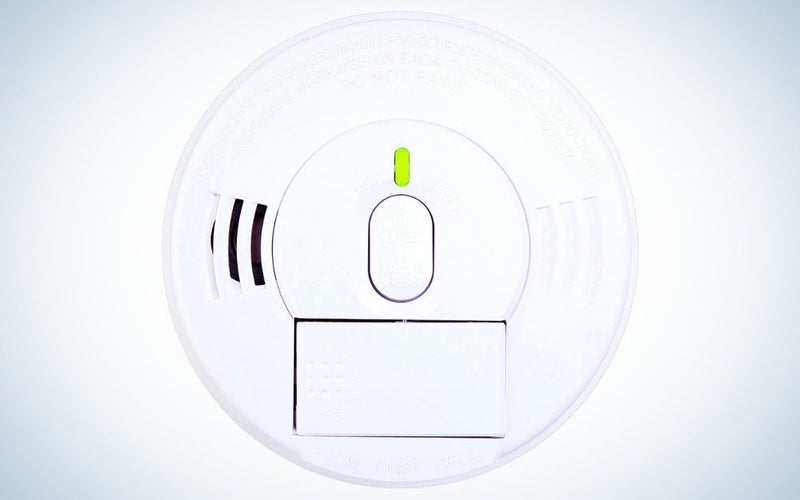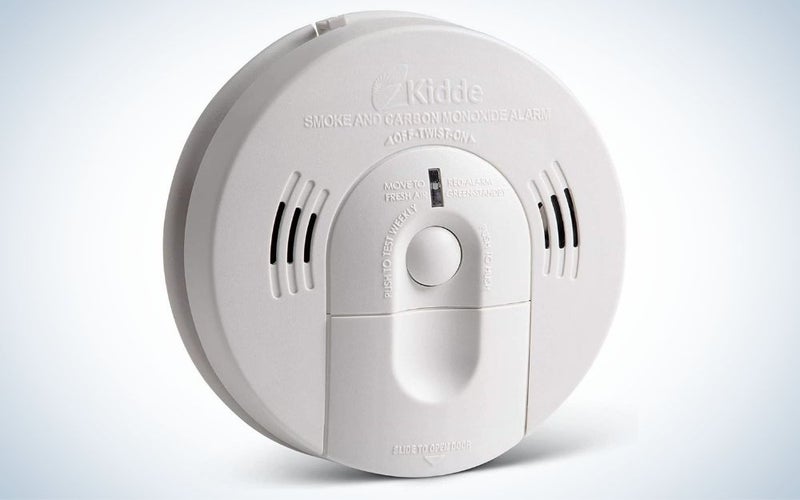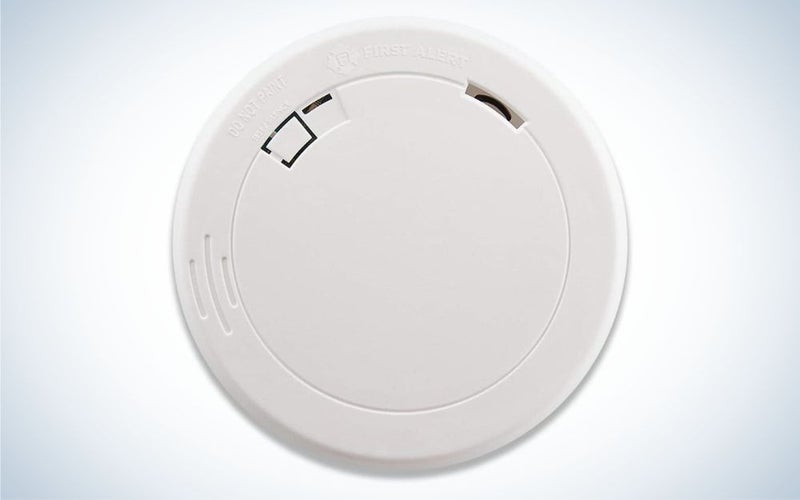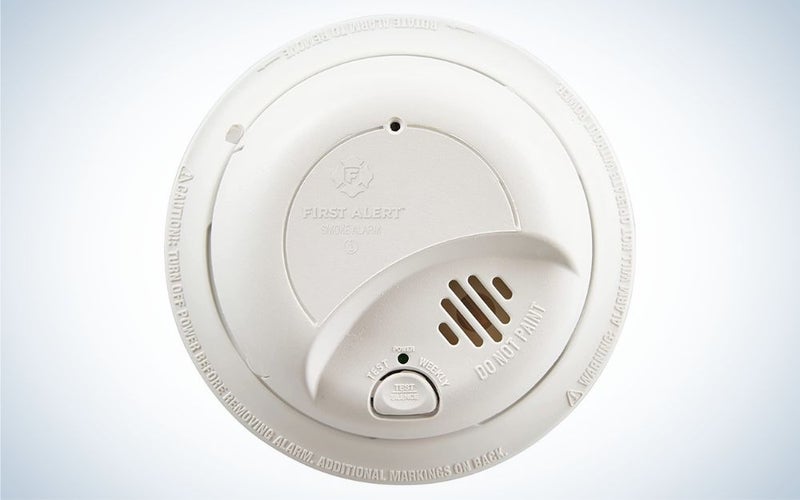We may earn revenue from the products available on this page and participate in affiliate programs. Learn more ›
According to the National Fire Protection Association, around two-thirds of home fire deaths happen in spaces without a smoke detector. It takes minutes for a fire to fill your home with thick black smoke. The critical warning they provide can mean the difference between life and death. If your detectors are broken or very old, you should take the time to replace them. Luckily, even the best smoke detectors are affordable and easy to install, and we’ve collected options for you to explore.
- Best photoelectric: First Alert SA511 CN2-3ST
- Best for kitchen: First Alert SCO7CN Combination Smoke and Carbon Monoxide Detector
- Best ionization: First Alert 9120B Smoke Detector
- Best for smoke and carbon monoxide detector: Kidde Smoke & Carbon Monoxide
- Best battery-powered: First Alert PR710 Slim Smoke Alarm
- Best smart: Google Nest Protect
- Best budget: Kidde Smoke Detector (i12060)
How we chose the best smoke detectors
I’ve been renting an apartment with my wife (and dog) for nearly 10 years, and during that time, I replaced our old smoke detector with something new. I regularly test the detector to ensure it’s in working order, and I also monitor the condition of our major appliances, wall heater, and fireplace for potential fire risk. These are just a few small steps necessary in a more comprehensive fire safety plan, including a fire extinguisher and escape route.
When I’m not obsessing over my family’s safety, I’m writing about gadgets and gear for publications like Popular Science, CNN Underscored, and TechnoBuffalo. To make these selections, I consulted fire safety guides from health and safety organizations, including NFPA.org, Ready.gov, and RedCross.org. I also reviewed PopSci’s previous coverage of the best practices for fire safety and consulted expert reviews.
The best smoke detectors: Reviews & Recommendations
Smoke detectors are extremely important for every home. If you haven’t replaced yours in the past decade, it’s time to buy a new set. The best detectors are affordable, reliable, and easy to install. More importantly, these fire alarms will provide you and your family with protection and peace of mind.
Best photoelectric: First Alert SA511CN2-3ST
FIRST ALERT
Why it made the cut: The First Alert SA511CN2-3ST packs powerful interconnectivity and voice alerts to let you know when there’s a fire.
Specs
- Type: Battery-powered (AA x 2)
- Sensor: Photoelectronic
- Interconnectivity: Yes
Pros
- Interconnectivity
- Simple setup
- Voice alert
Cons
- Limited number of location presets
The First Alert SA511CN2-3ST hits all the basic marks we look for in a smoke detector. This UL-Listed photoelectric model features interconnectivity so you can connect up to 18 smoke alarms across your home. You can also assign this fire detector with one of 11 pre-set home locations, so its voice alert can tell you where the smoke is coming from.
Since it is designed to work as part of a larger set, we recommend a two-pack of detectors to make it a little more affordable if you decide to replace a full set of smoke detectors. That said, you can always get an individual model as well.
Best for kitchen: First Alert SCO7CN Combination Smoke and Carbon Monoxide Detector
First Alert
Why it made the cut: This photoelectric smoke detector senses both smoke and carbon monoxide and has a triple alarm system, but can also distinguish between danger and a cooking mishap.
Specs
- Type: Battery-powered (AA x 2)
- Sensor: Photoelectric
- Interconnectivity: No
Pros
- Alerts to both smoke and high levels of carbon monoxide
- Provides multiple alarms: beeping, LED light, and voice
- Distinguishes between threats and overcooked meals
Cons
- Some users say it’s hard to change the batteries
- Alarm is shrill and difficult to turn off
Home fires are most likely to start in the kitchen, according to the Red Cross. That’s why you might want a dedicated smoke detector in the room. First Alert’s SCO7CN Combination Smoke and Carbon Monoxide Detector is a good choice. Its photoelectric sensor can detect smoldering fires, alerting you before you smell smoke or see flames. It’s designed with simultaneous alarms to let you know about smoke or high levels of carbon monoxide: a flashing LED light, beeping, and a voice alert. This kitchen smoke detector allows you to pre-program 11 potential threat locations in your home and can also help you pinpoint where the threat is coming from, so you can find the best escape route. That said, the device is also designed to detect between real danger and that concoction you left in the oven a little too long.
Best ionization: Kidde Smoke Detector (i12060)
Kidde
Why it made the cut: The Kidde Smoke Detector is simple, affordable, and offers powerful interconnectivity.
Specs
- Type: Hardwired (battery backup; 9-volt)
- Sensor: Ionization
- Interconnectivity: Yes
Pros
- Very affordable
- Interconnectivity
- Easily replaceable backup battery
Cons
- Requires professional installation
- Hardwired might work in all homes
If you’re already planning to get some electrical work done, this Kidde Smoke Detector is a very affordable hardwired smoke detector with a battery backup. It looks simple but can sync with up to 24 safety devices, including up to 18 smoke alarms. In addition to a hush/test button on the front, Kidde’s smoke detector also features a tamper-resistant locking pin, a low battery indicator, and a flashing LED, so you know it’s working. Conveniently, the unit also features a front-facing battery door, so you can easily replace the 9-volt battery. Small features like this can make a big difference, particularly if you’re in a space with multiple alarms.
Best for smoke and carbon monoxide: Kidde Smoke & Carbon Monoxide Detector
Kidde
Why it made the cut: If you don’t already own a carbon monoxide detector, Kidde’s combination smoke/CO alarm has you covered.
Specs
- Type: Battery-powered (9-volt)
- Sensor: Photoelectric
- Interconnectivity: No
Pros
- Also offers a carbon monoxide detector
- Voice alerts
- Easy battery replacement
Cons
- No interconnectivity
Kidde’s combination smoke and carbon monoxide alarm is an excellent option if you need to install both smoke and carbon monoxide detectors. The battery-powered combination alarm constantly monitors your home for smoke and gas, providing specific voice alerts if danger exists. (It also calls out “low battery” when it’s time to replace its 9-volt power source.) Kidde’s combination alarm also features a convenient hush/test button and a battery compartment on the front, making it easy to perform an annual battery change. For additional peace of mind at home, check out our guide to home security systems.
Best battery-powered: First Alert PR710 Slim Smoke Alarm
FIRST ALERT
Why it made the cut: With a slim profile and long-lasting battery, the First Alert PR710 Slim is a great way to protect your home.
Specs
- Type: Battery-powered (lithium-ion)
- Sensor: Photoelectric
- Interconnectivity: No
Pros
- Long-lasting battery
- Very little maintenance
- Slim profile
Cons
- No interconnectivity
If your home is too old for a hardwired smoke alarm, but you don’t want to change a battery ever, the First Alert PR710 Slim is a solid photoelectric smoke detector with a sealed lithium-ion battery guaranteed to last 10 years. Its thin, low-profile design is no-frills—just a single test/mute button, and that’s it. Unlike many of our other picks, it uses a classic siren rather than voice alerts. It also cannot sync with other alarms. All in all, it’s a great option for apartments and other small spaces where you just need one smoke alarm, and you’d prefer to buy a new smoke detector every 10 years than replace a set of batteries every few months.
Best smart: Google Nest Protect
Why it made the cut: The Nest Protect by Google provides a multitude of smart features in addition to smoke and CO detection.
Specs
- Type: Battery-powered or hardwired
- Sensor: Split-spectrum
- Interconnectivity: Yes
Pros
- Smartphone notifications
- Supports battery-powered and hardwired setups
- Split-spectrum sensor
- Advanced interconnectivity
Cons
- Expensive
The Google Nest Protect offers traditional smoke and carbon monoxide monitoring, with several convenient smart features. Chief among them, you receive a direct alert through the Nest smartphone app (for iOS and Android) when it detects danger. You can also conveniently mute the alarm through that alert. This smart smoke detector features a specialized photoelectric “Split-Spectrum” sensor, which uses two LED lights to detect a wider range of smoke particles. According to Google, the Split-Spectrum Sensor adds all the benefits of Ionization smoke detectors, without drawbacks like false alarms (or buying two types of smoke detectors).
Of course, the downside here is that the Nest Protect costs a lot more than any other smoke detector. In many cases, you can buy three standard photoelectric detectors for the price of one Nest Protect. It may be a convenient upgrade if you already have Nest gear at home, but it’s paying a pretty penny for the privilege. If you want connectivity throughout your home, consider these smart home devices.
Best budget: First Alert 9120B Smoke Detector
FIRST ALERT
Why it made the cut: The First Alert 9210B Smoke Detector supports interconnectivity, an easily accessible test/mute button, and a 9-volt backup battery system.
Specs
- Type: Hardwired (battery backup; 9-volt)
- Sensor: Ionization
- Interconnectivity: Yes
Pros
- Battery backup
- Interconnectivity
- Easily accessible test/mute button
Cons
- Hardwired means more difficult installation
The First Alert 9120B Smoke Detector is a hardwired ionization unit with a single test/mute button and a 9-volt battery backup system. It can also act as part of an interconnected, multi-unit alarm system of up to 12 First Alert smoke detectors, so you have more comprehensive coverage in your home. The 9120B also features a dust cover to keep particles from getting in, a mounting bracket lock for tamper resistance, and smart technology designed to reduce false and “nuisance” alarms.
Things to consider when buying the best smoke detectors
A smoke detector, or “smoke alarm,” senses the presence of smoke and blasts a loud alarm in response. While the options we’ve recommended vary in size and shape, home detectors typically feature plastic enclosures and are mounted high on a wall or ceiling.
“Today’s home fires burn faster than ever. In a typical home fire, you may have as little as two minutes to escape safely from the time the smoke alarm sounds,” says Susan McKelvey, communications manager at the National Fire Protection Association (NFPA). “Having working smoke alarms installed in the required locations throughout your home—at least one on every level of the home, in each bedroom, and near all sleeping areas—can make the difference between life and death in a home fire.”
Though modern smoke detectors seem ubiquitous and interchangeable, manufacturers use a couple of different methods to make them:
- Photoelectric smoke detectors trigger an alarm when smoke enters a chamber and reflects light onto a sensor. They protect better against slow, smoldering fires than fast, raging fires.
- Ionization smoke detectors feature a sensor with a small amount of radioactive material between two electrically charged plates. When smoke enters the chamber, the flow of ions becomes disrupted, activating the alarm. Ionization-type detectors are generally better at identifying fast-burning flaming fires.
Both photoelectric- and ionization-style detectors have advantages and disadvantages, so there is no one obvious choice. For comprehensive coverage, NFPA recommends using both kinds in your home. Some devices feature both technologies in a single device.
We recommend placing your smoke detectors based on their expertise. Use photoelectric detectors near stoves and outside of bathrooms, where smoke may accumulate over time from a small fire. Put ionization-style units in areas where fires are less likely to start so that they can catch fast-moving flames.
You shouldn’t have to think too much about your smoke detectors. A great one should be easy to install, take little effort to maintain, and accurately alert you when there’s an emergency. After installing a smoke detector, you shouldn’t even notice it’s there (unless it goes off). We considered dozens of options to find the best smoke detector. These factors separated the good detectors from the bad ones.
UL listing
The first and most important thing to look for in a smoke detector is a certification from Underwriters Laboratories, the safety science company that sets standards for equipment like smoke and carbon monoxide detectors. All smoke detector manufacturers must meet the company’s most recent standard for smoke alarms, ANSI/UL 217, to place a UL certification on their products. Essentially, the “UL Listed” seal of approval tells you that a detector has been tested to meet strict requirements and will work as advertised.
Hardwired vs. battery-powered
In addition to sensor technology, smoke detectors vary based on how they receive power. It’s worth keeping this in mind when you’re considering smoke detector installation. Most detectors rely on disposable batteries but hardwired models that you wire into your home’s power are also an option.
Battery-powered smoke detectors—which usually rely on disposable 9-volt, AA, or lithium cells—offer flexible placement. You can easily install one in any room in your home at any time. They also require slightly more maintenance, as you need to replace their batteries annually to ensure they’re operational. It’s important to note that manufacturers advise against using rechargeable batteries in smoke detectors, as they lose their charge more quickly and have a shorter runtime than standard disposable batteries.
Alternatively, some battery-powered detectors come with sealed-in lithium batteries designed to last 10 years, making it so you never have to worry about replacing a battery. Some states, including California, require you to use this kind of detector to prevent people from taking the batteries out when the alarm goes off. Check your state and city ordinances for the best guidance on what’s required in your area.
Other smoke detectors are designed to get hardwired into your home’s electrical system. This makes it so you’ll never have to replace a battery to keep them operational. That said, installing them is a much more time-intensive process and includes working with electrical wiring. If you purchase a hardwired detector, make sure to buy one that features a backup battery, which will keep your detectors on if your house loses power.
Interconnectivity
If you need to protect a large home with multiple floors, it helps to buy a set of “interconnected” smoke detectors that can sync with each other so that if one detector senses smoke, all of your alarms will go off. In the event of a serious, fast-moving fire, this will ensure that everyone in your home knows to get outside as quickly as possible.
Smart features
Most smoke detectors are relatively basic devices, but there are some newer “smart” models with internet-enabled features. If you’re in the market for wireless smoke detectors, these options will often sync up with a mobile app, allowing you to check their status and mute them from your phone. The app also can give you a warning before the alarm goes off, giving you a small window to silence it if you’re cooking or already know it’s a false alarm. Some even offer voice alerts and can tell you which detector senses smoke.
General best practices
So you’ve set up your new smoke alarm: what now? Steve Kerber, vice president and executive director of UL’s Fire Safety Research Institute (FSRI), says that frequent testing, not disabling smoke alarms (especially when cooking), and making a home fire escape plan is imperative to keeping you and your family safe.
“Your fire escape plan should include a plan A, B, and C,” Kerber says. “In Plan A, you exit through the nearest exit, most likely a door, close the door behind you as you exit, and head to your family’s meeting place to call 911. In Plan B, you exit through an alternate exit, which could be a window or a door located in a different part of the home, and, if you can, close the door or window behind you before going to your family’s meeting place to call 911. In Plan C, if you can’t get out, you get behind a closed door as far away from the fire as possible, turn on the light and do whatever you can to let the fire department know where you are inside the home. Cover the cracks with clothes, towels, drapes, or anything else available.”
McKelvey adds that it’s important also to check if your smoke alarm is still within its life limit, since they need to be replaced every 10 years.
“To do this, check the date of manufacture on the back of the alarm,” McKelvey says. “The smoke alarm should be replaced 10 years from that date or sooner if it begins to show signs of malfunction, such as when the alarm continues to chirp after the alarm is checked for dust or other disruptions and the batteries (if replaceable) are replaced.”
FAQs
Q: How much does a smoke detector cost?
Depending on features, a smoke detector can cost between $15-$120. Sets are more expensive up-front but are cost-effective in the long run.
Q: How often should I replace my smoke detector’s battery?
The U.S. Fire Administration and National Fire Protection Association recommend replacing the batteries in your smoke alarms at least once yearly. With a 10-year lithium battery, you should replace the detector when the battery gets low. Either way, you should test your alarms once monthly to ensure they work properly.
Q: How often should I replace my smoke detector?
You should consult the manufacturer’s instructions when replacing your smoke detector. In general, smoke alarms should be replaced every 10 years. This will ensure you always have a properly working unit that meets modern safety standards.
Q: How many smoke detectors should I install in my home?
It may sound like overkill, but the U.S. Fire Administration recommends you place a smoke detector inside and outside each bedroom and sleeping area. You should also have at least one smoke alarm on every level of your home to ensure every corner is covered. Remember, you only have a few minutes before conditions in your space become untenable from a raging fire, so it’s essential to have as early a warning as possible. An early warning could provide you with precious time to respond accordingly.
Q: What should I do if a smoke detector goes off while I’m cooking?
Everyone triggers a smoke alarm while cooking every once in a while. While “nuisance alarms” like these are annoying, you shouldn’t take the battery out of your detector. When a smoky kitchen threatens to set off the detector, press the alarm’s hush button and open nearby doors or windows. Then wave a towel at the alarm to help clear the air. You can also temporarily move the alarm away from your kitchen, but remember to move it back when the smoke clears.
Final thoughts on the best smoke detectors
- Best photoelectric: First Alert SA511 CN2-3ST
- Best for kitchen: First Alert SCO7CN Combination Smoke and Carbon Monoxide Detector
- Best ionization: Kidde Smoke Detector (i12060)
- Best for smoke and carbon monoxide detector: Kidde Smoke & Carbon Monoxide
- Best battery-powered: First Alert PR710 Slim Smoke Alarm
- Best smart: Google Nest Protect
- Best budget: First Alert 9120B Smoke Detector
A house fire can spread quickly, so every second counts. An early warning from a smoke detector can be the difference between life and death. Additionally, some smoke detectors come with a carbon monoxide detector built-in; others have smart capabilities and can send alerts to your phone. If your home isn’t properly outfitted with detectors, you should take the time to install them. It’s a worthy investment—your safety depends on it.
Why trust us
Popular Science started writing about technology more than 150 years ago. There was no such thing as “gadget writing” when we published our first issue in 1872, but if there was, our mission to demystify the world of innovation for everyday readers means we would have been all over it. Here in the present, PopSci is fully committed to helping readers navigate the increasingly intimidating array of devices on the market right now.
Our writers and editors have combined decades of experience covering and reviewing consumer electronics. We each have our own obsessive specialties—from high-end audio to video games to cameras and beyond—but when we’re reviewing devices outside of our immediate wheelhouses, we do our best to seek out trustworthy voices and opinions to help guide people to the very best recommendations. We know we don’t know everything, but we’re excited to live through the analysis paralysis that internet shopping can spur so readers don’t have to.
